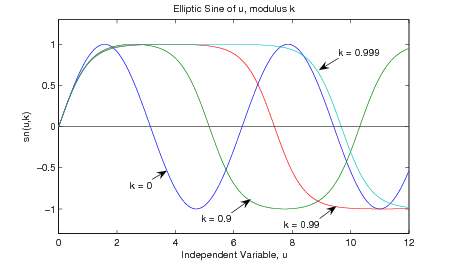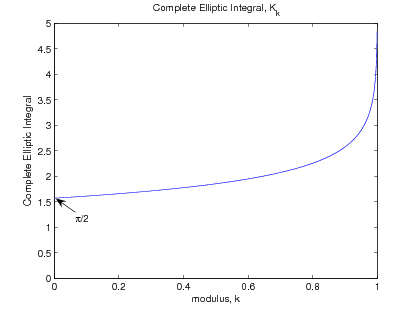| << Chapter < Page | Chapter >> Page > |
The trigonometric sine of the inverse of this function is defined as the Jacobian elliptic sine of with modulus , and is denoted
A special evaluation of [link] is known as the complete elliptic integral . It can be shown [link] that and most of the other elliptic functions are periodic with periods if is real. Because of this, is also called the “quarter period". A plot of for several values of the modulus is shown in [link] .

For k=0, . As approaches 1, the looks like a "fat" sine function. For , and is not periodic (period becomes infinite).
The quarter period or complete elliptic integral is a function of the modulus and is illustrated in [link] .

For a modulus of zero, the quarter period is and it does not increase much until k nears unity. It then increasesrapidly and goes to infinity as goes to unity.
Another parameter that is used is the complementary modulus defined by
where both and are assumed real and between 0 and 1. The complete elliptic integral of the complementary modulus is denoted .
In addition to the elliptic sine, other elliptic functions that are rather obvious generalizations are
There are six other elliptic functions that have no trigonometric counterparts [link] . One that is needed is
Many interesting properties of the elliptic functions exist [link] . They obey a large set of identities such as
They have derivatives that are elliptic functions. For example,
The elliptic functions are the solutions of a set of nonlinear differential equations of the form
Some of the most important properties for the elliptic functions are as functions of a complex variable. For a purely imaginaryargument
This indicates that the elliptic functions, in contrast to the circular and hyperbolic trigonometric functions, are periodic inboth the real and the imaginary part of the argument with periods related to and , respectively. They are the only class of functions that are “doubly periodic".
One particular value that the function takes on that is important in creating a rational function is
The rational function needed in [link] is sometimes called a Chebyshev rational function because of its equal-ripple properties.It can be defined in terms of two elliptic functions with moduli and by
In terms of the intermediate complex variable , and become
It can be shown [link] that is a real-valued rational function if the parameters , , and take on special values. Note the similarity of the definition of to the definition of the Chebyshev polynomial . In this case, however, n is not necessarily an integerand is not the order of the filter. Requiring that be a rational function requires an alignment of the imaginary periods [link] of the two elliptic functions in [link] , [link] . It also requires alignment of an integer multiple of the real periods. The integermultiplier is denoted by and is the order of the resulting filter [link] . These two requirements are stated by the following very important relations:

Notification Switch
Would you like to follow the 'Digital signal processing and digital filter design (draft)' conversation and receive update notifications?